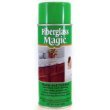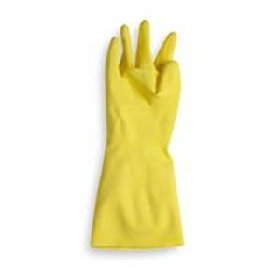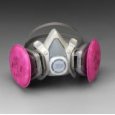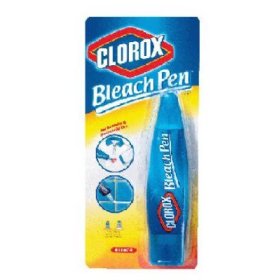My tub is now a nice shade of blue and scrubbing it with Ajax is NOT helping. Any ideas on how I can get it off
Name: Elisheva
Message: My work space right now is my bathroom...My tub is now a nice shade of blue and scrubbing it with Ajax is NOT helping. Any ideas on how I can get it off?
What is "it" that you need to get off? Rit or Deka all-purpose dye, fabric paint, Procion MX dye, or what? Did you immersion-dye in the bathtub, or just have some splashing from your dye bucket?
oops, sorry I forgot that detail. this is MX dye that got all over due to me washing out the shelf I was using to dye the items, spilling out dye at the bottom of my "project box" AND washing that out frequently...and last but not least, taking off rubber brands and rinsing out each and every item before I threw it into the wash (and that was about 150 things...)
Wow, that's not a problem I've ever seen before. Wherever I've lived, I've only ever had old-fashioned bathtubs with a porcelain finish over cast iron. Until the surface gloss gets worn off (and my current bathtub is sixty years old and still plenty glossy), the porcelain absolutely does not stain with Procion MX dyes. Soap scum or dirt on the surface of the tub will pick up dye, but that's easily removed, obviously not your problem since you've already tried scouring powder without success.
Presumably your bathtub is made of a more "modern", cheaper material, unless it's porcelain with the glossy surface all worn off, or a tub that was refinished some time ago. It might be made of fiberglass, or acrylic. Neither of these will react with Procion MX dye, the way that cellulose (cotton, rayon, or wood) or protein (wool or silk) might do. What I'm afraid of is that one of these might have a more porous nature. If it has actually absorbed the dye into itself, it will be much harder to remove—as you have already observed.
The first step is to scrub as thoroughly as possible,
using a bleach-containing powder, such as your Ajax. Since that has failed,
you'll want to try something else.
possible,
using a bleach-containing powder, such as your Ajax. Since that has failed,
you'll want to try something else.
If your bathtub has been refinished, or if it is made of fiberglass or acrylic, you may need to stick to whatever cleaners are recommended by the manufacturer. If you are renting, the only way to find out if this is the case is to ask the apartment management.

If the material your tub is made of does not react badly to chlorine bleach, you could probably use that to break up and decolorize the dye molecules. However, I've read that some bathtubs develop an ugly reddish-brown stain when treated with bleach. You should test a small area before treating much of your tub with bleach. (According to the Clorox company, you can use "Clorox 2 Bleach for Colors", which is a perborate-based laundry cleaner that liberates peroxide, to remove reddish-brown bathtub stains produced by bleach-containing cleansers.)
Be aware that, for all its familiarity, chlorine
bleach
chlorine
bleach
 (active
ingredient: hypochlorite) is a dangerous, toxic chemical. Wear reusable
housecleaning rubber gloves, rather than the thin disposable latex gloves that
often get holes in them. Use fans to provide good ventilation. If too much
exposure to the fumes from the bleach is inevitable, wear a properly-fitting
respirator, outfitted with with acid gas cartridges, to protect you from
breathing the bleach
fumes.
(active
ingredient: hypochlorite) is a dangerous, toxic chemical. Wear reusable
housecleaning rubber gloves, rather than the thin disposable latex gloves that
often get holes in them. Use fans to provide good ventilation. If too much
exposure to the fumes from the bleach is inevitable, wear a properly-fitting
respirator, outfitted with with acid gas cartridges, to protect you from
breathing the bleach
fumes.

How to keep the bleach on the surface long enough to fully act? You might put a rag on the surface and dampen it with liquid bleach, or for small areas you could use the thickened bleach in a Clorox Bleach Pen, or for larger areas you could apply a dishwasher detergent whose label claims "with bleach" and whose ingredients include hypochlorite. Be very careful to avoid any situation in which the bleach might become mixed with any other cleaner, which might contain ammonia (producing deadly chloramine gas), or with any acid such as vinegar or toilet cleaner (producing deadly chlorine gas). Leave your bleach to act for some time, then rinse thoroughly. Be aware that this treatment can damage the grout between floor tiles.
(Please help support this web site. Thank you.)
Message: My work space right now is my bathroom...My tub is now a nice shade of blue and scrubbing it with Ajax is NOT helping. Any ideas on how I can get it off?
What is "it" that you need to get off? Rit or Deka all-purpose dye, fabric paint, Procion MX dye, or what? Did you immersion-dye in the bathtub, or just have some splashing from your dye bucket?
oops, sorry I forgot that detail. this is MX dye that got all over due to me washing out the shelf I was using to dye the items, spilling out dye at the bottom of my "project box" AND washing that out frequently...and last but not least, taking off rubber brands and rinsing out each and every item before I threw it into the wash (and that was about 150 things...)
Wow, that's not a problem I've ever seen before. Wherever I've lived, I've only ever had old-fashioned bathtubs with a porcelain finish over cast iron. Until the surface gloss gets worn off (and my current bathtub is sixty years old and still plenty glossy), the porcelain absolutely does not stain with Procion MX dyes. Soap scum or dirt on the surface of the tub will pick up dye, but that's easily removed, obviously not your problem since you've already tried scouring powder without success.
Presumably your bathtub is made of a more "modern", cheaper material, unless it's porcelain with the glossy surface all worn off, or a tub that was refinished some time ago. It might be made of fiberglass, or acrylic. Neither of these will react with Procion MX dye, the way that cellulose (cotton, rayon, or wood) or protein (wool or silk) might do. What I'm afraid of is that one of these might have a more porous nature. If it has actually absorbed the dye into itself, it will be much harder to remove—as you have already observed.
The first step is to scrub as thoroughly as
 possible,
using a bleach-containing powder, such as your Ajax. Since that has failed,
you'll want to try something else.
possible,
using a bleach-containing powder, such as your Ajax. Since that has failed,
you'll want to try something else.If your bathtub has been refinished, or if it is made of fiberglass or acrylic, you may need to stick to whatever cleaners are recommended by the manufacturer. If you are renting, the only way to find out if this is the case is to ask the apartment management.

If the material your tub is made of does not react badly to chlorine bleach, you could probably use that to break up and decolorize the dye molecules. However, I've read that some bathtubs develop an ugly reddish-brown stain when treated with bleach. You should test a small area before treating much of your tub with bleach. (According to the Clorox company, you can use "Clorox 2 Bleach for Colors", which is a perborate-based laundry cleaner that liberates peroxide, to remove reddish-brown bathtub stains produced by bleach-containing cleansers.)
Be aware that, for all its familiarity,
 chlorine
bleach
chlorine
bleach
 (active
ingredient: hypochlorite) is a dangerous, toxic chemical. Wear reusable
housecleaning rubber gloves, rather than the thin disposable latex gloves that
often get holes in them. Use fans to provide good ventilation. If too much
exposure to the fumes from the bleach is inevitable, wear a properly-fitting
respirator, outfitted with with acid gas cartridges, to protect you from
breathing the bleach
fumes.
(active
ingredient: hypochlorite) is a dangerous, toxic chemical. Wear reusable
housecleaning rubber gloves, rather than the thin disposable latex gloves that
often get holes in them. Use fans to provide good ventilation. If too much
exposure to the fumes from the bleach is inevitable, wear a properly-fitting
respirator, outfitted with with acid gas cartridges, to protect you from
breathing the bleach
fumes. 
How to keep the bleach on the surface long enough to fully act? You might put a rag on the surface and dampen it with liquid bleach, or for small areas you could use the thickened bleach in a Clorox Bleach Pen, or for larger areas you could apply a dishwasher detergent whose label claims "with bleach" and whose ingredients include hypochlorite. Be very careful to avoid any situation in which the bleach might become mixed with any other cleaner, which might contain ammonia (producing deadly chloramine gas), or with any acid such as vinegar or toilet cleaner (producing deadly chlorine gas). Leave your bleach to act for some time, then rinse thoroughly. Be aware that this treatment can damage the grout between floor tiles.
(Please help support this web site. Thank you.)
Posted: Sunday - November 25, 2007 at 02:53 PM
Follow this blog on twitter here.
Quick Links
- All About Dyes & Dyeing Top -
- Top of this blog -
- FAQ -
- The Dye Forum -
- How to Tie Dye - How to Batik -
- Books - Toys - Plants -
- Top of this blog -
- FAQ -
- The Dye Forum -
- How to Tie Dye - How to Batik -
- Books - Toys - Plants -
More in this category:
- -
Statistics
Total entries in this blog:
Total entries in this category:
Published On: Aug 29, 2012 02:47 PM
Total entries in this category:
Published On: Aug 29, 2012 02:47 PM